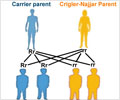Nearly three out of four Japanese patients who underwent living donor liver transplantation following acute liver failure managed to live for more than ten years after the surgery.

According to the AASLD, roughly 2,000 Americans develop ALF—formally called fulminant hepatitis—each year, with many of these cases caused by acetaminophen (Tylenol) overdose, drug-induced liver injury, autoimmune liver disease, or viral hepatitis. Previous studies report patient survival from ALF was less than 15% before the era of liver transplantation and significantly better at more than 65% following transplantation.
LDLT—when a portion of a healthy liver from a living donor is used for transplantation—was developed as an alternative treatment option to overcome the shortage of deceased donor organs. A 2007 study by de Villa et al. found that LDLT accounts for less than 5% of liver transplants in the U.S. and Europe compared to more than 90% in Asia excluding mainland China.
"ALF is a rare, life-threatening condition where the rapid deterioration of liver function causes changes in mental activity and disrupts the body's blood clotting capabilities," explains lead author Dr. Yasuhiko Sugawara, Associate Professor in the Graduate School of Medicine at the University of Tokyo in Japan. "Expanding knowledge of treatment options, such as LDLT, that improve patient outcome is imperative."
Using data from the Intractable Liver Disease Study Group of Japan, researchers identified 209 ALF candidates who underwent living donor liver transplantation. The authors report that in patients who underwent LDLT the cumulative one-year, five-year and ten-year survival rates following transplantation were 79%, 74%, 73%, respectively. Patient age impacted short-term and long-term mortality, while donor age only affected long-term patient mortality.
"Our study demonstrates the benefit of LDLT in a Japanese population, which has less access to deceased donor organs," concludes Dr. Sugawara. "Prospective studies are needed to determine the overall impact of LDLT in all patients with ALF."
Advertisement
"Deceased donor liver transplantation is dictated by the availability of the organ, and high-risk marginal grafts are frequently used. LDLT allows for early transplant to avoid waitlist mortality and better timing of the operation, which can be performed at the first sign of patient deterioration," concludes Professor Lo. "LDLT for ALF has developed in Asia because there is no choice. Is it possible that it may in fact be a better choice?"
Advertisement
Source-Eurekalert















